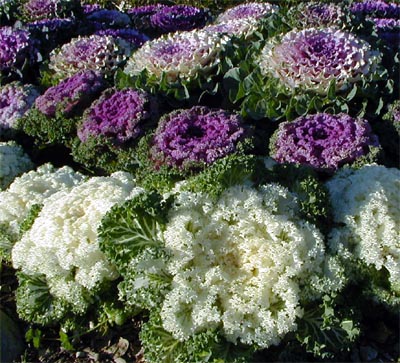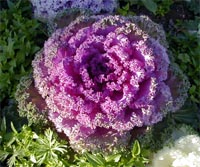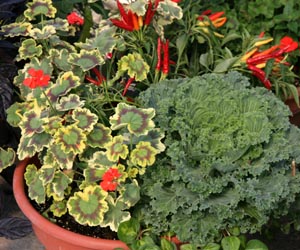
In the fall, chrysanthemums and pansies are the predominant plants offered for seasonal color. But another group of cold-tolerant plants without flowers can help brighten the fall garden when almost everything else is looking tired and ready for winter. Ornamental cabbage and kale are the same species as edible cabbages, broccoli, and cauliflower (Brassica oleracea) but have much fancier and more colorful foliage than their cousins from the vegetable garden. While these plants are sometimes offered as “flowering” cabbage and kale, they are grown for their large rosettes of colorful leaves, not the flowers. These plants are very showy and come in a variety of colors, ranging from white to pinks, purples or reds. Even though they are technically all kales (kale does not produce a head; instead, it produces leaves in a tight rosette), by convention those types with deeply-cut, curly, frilly or ruffled leaves are called ornamental kale, while the ones with broad, flat leaves often edged in a contrasting color are called ornamental cabbage. The plants grow about a foot wide and 15” tall.

Ornamental cabbages and kales do not tolerate summer heat and plants set out in spring will likely have bolted or declined in appearance, so it is necessary to either start from seed in mid-summer or purchase transplants for a good fall show. Seeds must be sown and young plants kept under cool conditions to thrive, so this is a project best suited for a greenhouse where the temperature can be controlled. In cooler locations you may be able to sow the seeds directly in the garden. Otherwise, try placing the pot(s) with seeds in the refrigerator for several days to encourage germination. The seeds require light for germination, so do not cover them with soil. Sow your seeds about 6-10 weeks before the first frost.

Until it gets cool, the plants won’t have much color. The white, pink, or red pigments really begin to show with frost and cold weather, getting great, vivid colors below 50°F. They really are cool-weather plants, and once acclimated they can survive temperatures as low as 5°F, so they may last well into November and December.
When purchasing ornamental cabbage or kale, look for large, compact plants that are nearly or fully colored. The plants will generally not get much bigger after planting in the garden, particularly if the roots are pot bound, so you should try to buy the size you want (even though the biggest plants will cost more).

Wait until temperatures start cooling down, then plant in a sunny location in a moderately moist, rich soil. Bury the stem so the lowest leaves are flush with the soil surface. Keep the plants well watered. Ornamental cabbage and kale are great for replacing worn out summer annuals for a long-lasting fall display. Try to position them where you will see the colorful centers. Use them in mass plantings, in mixed or single container plantings and as edgings. They look beautiful in the front of a border, especially when combined with perennials that are at their peak in the fall, such as little bluestem grass (Schizacrium scoparium), tall, dark-leaved sedums or asters. For an easy and attractive container planting, place an ornamental cabbage or kale in the center and pansies around the edge. Or try them with other plants that can tolerate light frosts, such as Swiss chard, snapdragons or petunias.

Cabbage worms, cutworms, aphids, and slugs like these plants, but because of the season, the plants likely will not have the same pest problems they would if grown earlier in the year.
Both ornamental cabbage and kale are edible, although they tend to be more bitter than the edible cultivars (and the pretty colors turn an unappetizing gray when cooked). Ornamental kale leaves are often used as a garnish on plates in place of parsley.
There are many cultivars available. Some common ones include:
- ‘Chidori’ Series – a mounded kale type with purple foliage with extremely curly leaf margins and a cream white or deep magenta center.
- ‘Color Up’ Series – a cabbage type with an upright growth habit with columnar type of appearance, green leaves and colored center in white, blush pink or fuchsia.
- ‘Nagoya’ Series – round with heavily crinkled leaves and a tight rosette center that ranges in color from fuchsia pink, lavender, yellow green to creamy white.
- ‘Osaka’ Series – very fast growing and compact cabbage type with bluish-green, semi-waved leaves and a pink, red, or white center.
- ‘Peacock’ Series – these compact hybrids have deeply serrated, feathery red or white leaves.
- ‘Pigeon’ Series – look like flat heads of cabbage with red or white centers. They can be single head or triple heads.
- ‘Tokyo’ Series – nearly perfectly rounded cabbage type with smooth, blue-green outer leaves and soft pink, red, or white centers.
– Susan Mahr, University of Wisconsin – Madison





 Marigolds
Marigolds Create a Butterfly Garden
Create a Butterfly Garden Plant Flowers to Encourage Beneficial Insects
Plant Flowers to Encourage Beneficial Insects Forcing Bulbs
Forcing Bulbs


